Barriers to Understanding Hotel Living
For over twenty years, the supply of residential hotel rooms has not met demand. In about 1970, reporters began to write about a situation they called the "SRO crisis," which highlights long-standing themes in the history of hotels. For city planners and housing experts, "SRO" does not mean standing room only. It means single room occupancy and refers either to an entire hotel or to a room within such a hotel. SROs are the most inexpensive types of residential hotels. They are almost entirely residential, offering few, if any, tourist rooms. For social workers, the term "SRO" means single room occupants—not the buildings but the residents.[23] If the rebuilding of our cities continues in its current path, the acronym SRO may indeed soon mean "standing room only." As the supply of residential hotel rooms rapidly dwindles, former hotel residents join the homeless on American streets and in city shelters. In
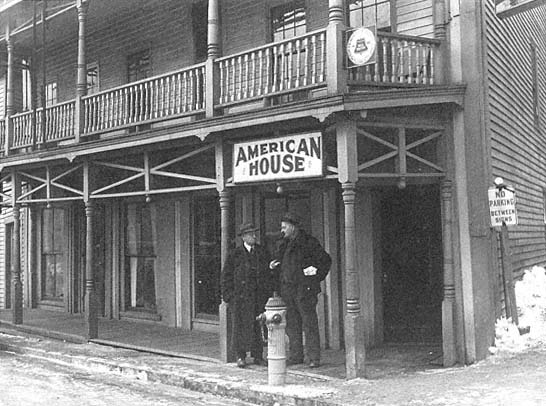
Figure 1.4
World War II shipyard workers photographed outside their hotel in Bath, Maine, 1940.
part, the present crisis results from misconceptions about who currently lives in hotels and has its roots in a cultural amnesia about this alternative downtown housing style.
The SRO Crisis as a Subset of Today's Hotel Life
SRO hotels are a subset of hotel life but its most important subset, both historically and in the present. Inexpensive hotels have pushed the traditional patterns of hotel life to social and practical limits. Statistics from most cities show that since World War II the United States has been losing affordable hotel homes at staggering rates and not replacing them. Downtown hotel owners, to improve their income or to eliminate management problems, have converted SROs to tourist rooms or other uses, torn the buildings down and built office towers, or simply closed the buildings. Between 1975 and 1980, San Francisco landowners eliminated 6,085 units, almost a fifth of the city's entire stock of residential hotel units. Chicago lost almost 23,000 units between 1973 and 1984.[24] A typical public housing project has about 250 units; thus, Chicago's
loss—in units—is equivalent to the loss of 92 housing projects. Some observers see these losses as positive developments—the removal of substandard housing and unwanted neighbors. To others, this wholesale closing and destruction of residential hotels is a major tragedy and a root cause of homelessness in the United States. These opposing views are not new; they have existed at least since the 1860s. Essential resource or public nuisance? How can one housing type be called both for more than one hundred years? How can the question remain open when the homes of as many as two million Americans depend on the outcome?
The lives of SRO residents inextricably intertwine with downtown hotel buildings; some residents literally cannot exist without them. Few, if any, housing alternatives for these residents exist. When owners close a building, tenants are lucky if they can find a worse hotel at higher rents. As the hotel stock dwindles, the option of moving evaporates, and tenants move to the streets. The street option has become increasingly evident in the numbers of America's homeless and street people. Even officials who dislike hotel life become alarmed as they realize that the closing of a 100-room hotel means that perhaps 150 more people may be living on the streets.[25]
In part because of the SRO crisis, myths about today's hotel residents abound. Hotel people are supposedly all friendless, isolated, needy, and disabled; all elderly; all on welfare; all elderly men; or all welfare mothers with three young children. All are presumably socially marginal, all mildly psychotic, all alcoholics or drug addicts, all drifters and transients who never live anywhere more than a few months; they are thought to be people whose homes cost taxpayers millions of dollars because of political corruption and bureaucratic waste. In spite of residents like Cyril Magnin and Dorothy Johnson, the most pervasive misconception about today's hotel residents is that they are all poor.[26] Journalists have made "welfare hotel" a synonym for all hotel life. In New York and other American cities, inexpensive hotels have become, in Jonathan Kozol's phrase, refugee camps for the American poor.[27] Each of these characteristics is sadly true of conditions in particular SRO buildings. However, not all SROs and certainly not all residential hotels with higher rents reflect such conditions.
Several recent studies dispel the stereotypes. For instance, fewer hotel tenants live on welfare than newspaper headlines suggest. Workers liv-
ing in hotels are still important to the urban economy. The authors of a San Diego study found that over half of the residents (and often more) were "independent, self-reliant individuals who were not dependent on public or private social services, nor had they been in the past." The older tenants often had fixed incomes, and the average tenure at the longest-held job was about twenty-one years. At the cheapest price range, a 1985 study of the SRO residents in Chicago found "a small prosperous minority, a majority barely earning enough to make ends meet, and a large minority of impoverished workers."[28] Where racial and ethnic minorities have low incomes, there hotels are also typically an important housing resource. In New York, a third of all SRO residents are black; a quarter are Hispanic. In San Francisco and Los Angeles, newly arrived families from Southeast Asia make up an increasing proportion of hotel residents. In San Francisco's Clayton Hotel, half of the residents are retired Filipino or Chinese laborers who, like Felix Ayson, have lived in one hotel seasonally for twenty to forty years.[29]
Not all single room occupants are single people. In New York, one-half of the SRO occupants are single; they occupy about three-fourths of the city's SRO units. Nor are all hotel residents transients. Some do move frequently, but the majority of America's hotel tenants move no more often—in many cases less often—than apartment renters.[30] Visiting nurses in the 1970s used to joke that "you could tell how long someone had lived in their hotel room by counting the layers of nicotine on the walls."[31] Their joke described both long residence and poor building maintenance. Nor are all SRO tenants elderly. The average elderly population in a city's hotels is about one-half of the total number of SRO occupants. In New York City in 1985, 43 percent of all SRO residents were under forty years old, and an additional 32 percent were between forty and sixty. Also contrary to popular opinion, the demand for hotel life among the elderly is not dwindling.[32]
More than other types of hotels, today's SROs have fueled a fierce debate about the history and the future of hotel life. Hotels are often the cheapest private housing available close to downtown. Many housing professionals and social workers today insist that hotel living is not only viable but essential to urban economy and urban society. Hotels, the apologists argue, are a valuable civic resource and respectable housing. The hotel defenders say that the people who choose hotel life do so
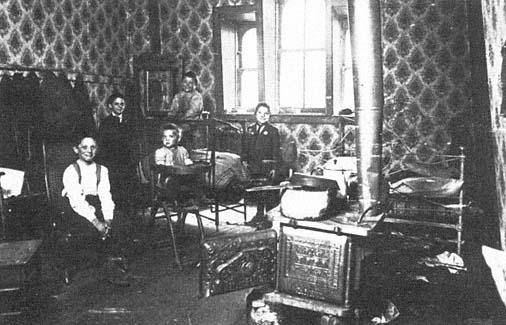
Figure 1.5
A hotel family of Eastern European immigrants in Chicago, 1910.
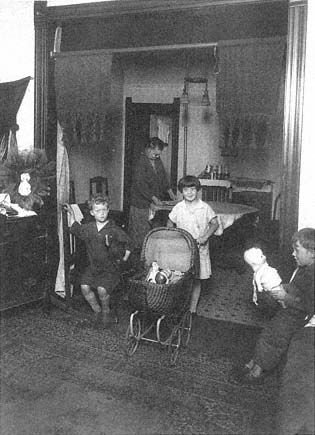
Figure 1.6
A hotel family of recent migrants to Chicago, 1929.
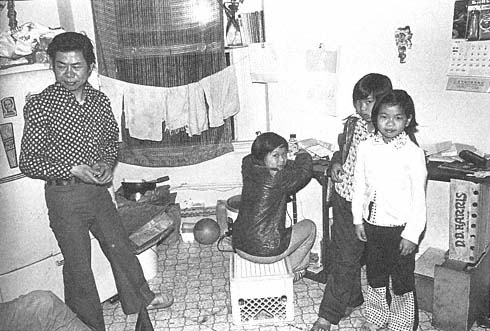
Figure 1.7
A hotel family of Southeast Asian immigrants in San Francisco, 1980.
for good reasons. The promoters propose (against loud clamors from the other side) that cities should be building more residential hotels.
Although the term "SRO" is relatively new, for at least one hundred years other commentators have railed against the real and implied dangers of single-room housing. In 1916, Walter Krumwilde, a Protestant minister, saw the rooming house or boardinghouse system "spreading its web like a spider, stretching out its arms like an octopus to catch the unwary soul."[33] Early social workers abhorred the idea of commercialized, retail housing for the poor. Generations of hotel critics have used photographs of families living in single rooms to shock Americans into recognition of SRO problems and to prompt ameliorative action. These different eras of hotel family portraits have a haunting similarity (figs. 1.5, 1.6, 1.7). Today many city health officials, architects, city planners, and politicians still argue that no one should live in hotels. Hotels, they say, exhibit severe social and physical maladjustment. Eliminating the hotel stock, the critics argue, will eliminate a public nuisance. One of the recurring complaints from people who are fighting for hotel residents is that no one seems to know very much about hotel people or the buildings they live in. This ignorance is not an accident.
Cultural Invisibility
Hotel residents and buildings are real enough, but they stubbornly remain outside of public awareness. Not surprisingly, two of the path-breaking books of the 1970s on SROs have the words "unseen" and "invisible" in their titles.[34] Early in the fight to make hotel life better understood, a St. Louis observer, Ira Ehrlich, summarized the problem in direct terms:
Single room occupants are omitted in the language of housing legislation, written off in the minds of communities, ignored and rejected in urban development plans, and pushed from one area to another on the waves of fluctuating real estate markets.[35]
More recently a San Francisco architect and scholar, John Liu, has written that "the Single Room Occupancy (SRO) residential hotel is perhaps the most controversial, the most neglected, and the least understood of all housing types."[36]
Hotel lives are culturally invisible in part because the public is disinterested and ignorant about any housing needs of the poor. Cushing Dolbeare, a founder and longtime executive director of the National Coalition for Low-Income Housing, complains, "As a problem, housing often eludes our grasp. It does not gain the political constituency it deserves. Other than homelessness, housing needs are simply not visible to most Americans."[37] Another barrier to understanding hotel life is based on the fact that so many hotel people are single and have developed social orders strongly differing from those in traditional American family units. Housing needs for single people—twenty-five years of age or fifty-five years of age—are rarely discussed even by housing experts. One of the path-breaking New York hotel activists, Carroll Kowal, writes that "federal housing policy deals with the population it is comfortable with: the family. Housing authorities have no understanding of non-family persons," let alone living units with no kitchens and a bath down the hall.[38] The numbers of single people tend to be underestimated throughout our society, even though they have always been an important share of the American adult population. In 1980, America had about 50 million married households and 21 million people living alone.[39]
Small hotels, which can make up half of a city's residential hotel stock, are easy to miss because the hotel rooms are usually on second and third floors above retail shops. Signs left from the 1920s feebly
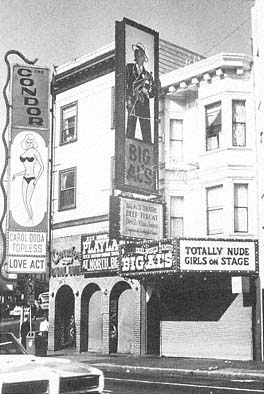
Figure 1.8
The corner of Broadway and Columbus Avenue
in San Francisco's North Beach neighborhood
in 1985. Between Big Al's and the Condor Club
is the small street entrance to the residential
hotel above Big Al's.

Figure 1.9
Isometric drawing of the Sierra House, the rooming
house above Big Al's North Beach nightclub.
announce the upstairs hotel functions while public attention is distracted by the signs and show windows of stores, restaurants, and nightclubs. In San Francisco's North Beach entertainment district, Carol Doda's sign and club at Broadway and Columbus were wellknown landmarks to tourists and residents (fig. 1.8). Yet within three hundred feet of that sign, on the second and third floors of the buildings, are over three hundred hotel homes (fig. 1.9).[40] Virtually no one passing on Broadway thinks about those seventy-year-old dwellings, or who lives in them.
More expensive hotel life is hard to see as well. Travelers in expensive hotels assume everyone else is a transient guest, too. Old buildings with names like the Barrington prompt the belief that they have always been apartment buildings when, in fact, they were originally hotels. At a public meeting in 1981, Melvin Carriere, a vice president in San Francisco's Wells Fargo Bank, confessed that he had never heard of a residential hotel or the notion of living in one until a community group asked for a hotel loan. He had been passing residential hotels every day
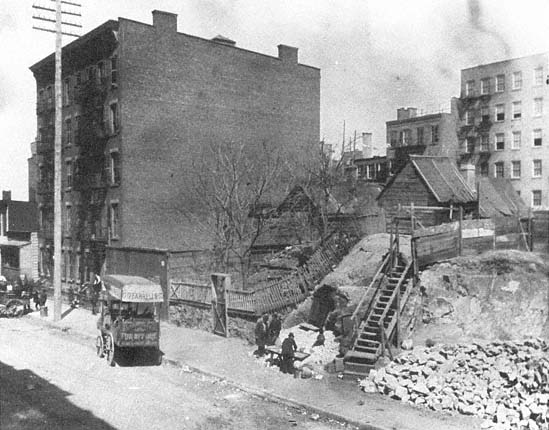
Figure 1.10
The unfinished city. Jacob Riis's photograph of small wooden shacks next to a brick tenement
in Hell's Kitchen in New York City emphasized the problems of old city rules.
on his way to work but had never noticed them. "I couldn't believe people wanted to live in a hotel," he added.[41]
Another barrier to understanding hotels is revealed when writers persist in labeling all people who live in hotels or motels as "homeless." The horrors of New York's welfare hotels or the squalor of a Los Angeles residential motel frequently matches the worst of homeless conditions. But if not overcrowded, a good hotel room of 150 square feet—dry space, perhaps with a bath or a room sink, cold and sometimes hot water, enough electric service to run a 60-watt bulb and a television, central heat, and access to telephones and other services—constitutes a living unit mechanically more luxuriant than those lived in by a third to a half of the population of the earth. As Dolores Hayden reminds us, many of the world's people would consider an American two-car garage an excellent dwelling in its own right.[42] The urban Americans living in hotels are not homeless. They are living in admittedly minimal and unusual dwelling units, often in hideous re-
pair and under woefully inadequate management but dwelling units nonetheless. Calling SRO people homeless reinvokes the cultural bias against hotel life. In the long run, the ecologically and culturally aberrant idea about housing may prove to be the huge single-family house on an open lot, not the more social way of living downtown in a hotel.
Other barriers to appreciating hotels have to do with the different notions people have about the ideal city. Supporters of hotels and those who see them as perverse ghettos hold deeply rooted and opposing conceptions about the proper rules for building urban space. The old city view stems from centuries-old European mercantile cities that had an urbane, densely congregated way of living with mixed income groups, adjacencies of housing, commerce, and workshops, all in buildings that crowded their lots and the street, with very little guarantee of permanence or a finished state (fig. 1.10). Downtown American hotel districts are a holdover of old city life.
After 1880, visionary experts and commercial leaders in America worked feverishly on building a new kind of city. Faced with the social and physical problems of industrialization in cities, directed by the needs and values of business elites, and reinforced by discoveries in public health, reformers consciously rejected the building and land-use rules of the old city. Beginning in large new suburbs, in vast industrial works, and in monumental architectural projects downtown, reformers and property developers embraced a modern set of architectural rules built around separation and specialization. The new rules promised each function in an area by itself, uniformity within areas, less mixture of social classes, maximum privacy for each family, much lower density for many activities, buildings set back from the street, and a permanently built order (fig. 1.11). By the 1890s, new city ideas had begun to be popular, particularly among the middle and upper class. Promoters of the new city planned for hotel living to be a deliberate casualty of the transition between the old city and the new city. Thus, as early as the 1890s, hotels had begun to be forbidden housing; their residents, forbidden citizens. These tensions between ideals were particularly clear in rapidly growing new cities.